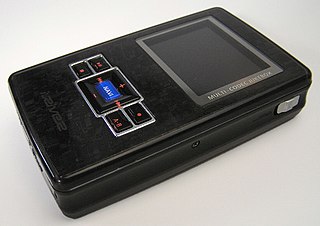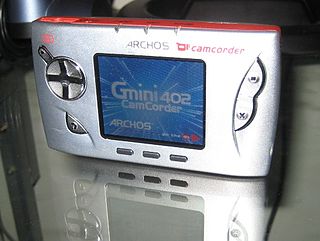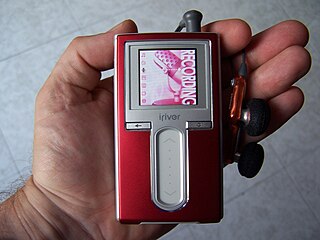Windows Media Audio (WMA) is a series of audio codecs and their corresponding audio coding formats developed by Microsoft. It is a proprietary technology that forms part of the Windows Media framework. WMA consists of four distinct codecs. The original WMA codec, known simply as WMA, was conceived as a competitor to the popular MP3 and RealAudio codecs. WMA Pro, a newer and more advanced codec, supports multichannel and high resolution audio. A lossless codec, WMA Lossless, compresses audio data without loss of audio fidelity. WMA Voice, targeted at voice content, applies compression using a range of low bit rates. Microsoft has also developed a digital container format called Advanced Systems Format to store audio encoded by WMA.

Windows Media Player (WMP) is the first media player and media library application that Microsoft developed to play audio and video on personal computers. It has been a component of the Microsoft Windows operating system, including Windows 9x, Windows NT, Pocket PC, and Windows Mobile. Microsoft also released editions of Windows Media Player for classic Mac OS, Mac OS X, and Solaris, but has since discontinued them.

ZEN is a series of discontinued portable media players designed and manufactured by Creative Technology Limited. The players evolved from the NOMAD brand through the NOMAD Jukebox series of music players, with the first separate "ZEN" branded models released in 2004. The last Creative Zen player, X-Fi3, was released at the end of 2011.

Rockbox is a free and open-source software replacement for the OEM firmware in various forms of digital audio players (DAPs) with an original kernel. It offers an alternative to the player's operating system, in many cases without removing the original firmware, which provides a plug-in architecture for adding various enhancements and functions. Enhancements include personal digital assistant (PDA) functions, applications, utilities, and games. Rockbox can also retrofit video playback functions on players first released in mid-2000. Rockbox includes a voice-driven user-interface suitable for operation by visually impaired users.

A portable media player (PMP) is a portable consumer electronics device capable of storing and playing digital media such as audio, images, and video files. The data is typically stored on a compact disc (CD), Digital Versatile Disc (DVD), Blu-ray Disc (BD), flash memory, microdrive, SD cards or hard drive; most earlier PMPs used physical media, but modern players mostly use flash memory. In contrast, analogue portable audio players play music from non-digital media that use analogue media, such as cassette tapes or vinyl records.

The Rio Carbon is a line of digital audio players that was produced by the now defunct Rio from 2004 to 2005. It was similar in size, capacity, and cost with Apple's iPod Mini which debuted earlier the same year. This was Rio's second player to use a miniature hard disk for storage, after the Rio Nitrus, which was first to market with a 1.5 GB drive in late 2003.

The Rio Karma is a digital audio player originally made by the now-defunct Rio. It was released in August 2003. It measures 2.7 × 3 × 0.9 inches and weighs 5.5 ounces. It has a 20 gigabyte hard drive. The Karma is notable for its support of Ogg Vorbis and FLAC playback in addition to the usual MP3 and WMA formats, however it will not play MP2 format. It also bears the distinction of supporting file transfers via Ethernet through its docking station, as well as the standard USB 2.0. It is not supported as a plug and play removable drive, although the program Rio Taxi does allow any data to be stored. Like many Rio players, the Karma's firmware features a 5-band parametric equalizer, cross-fader, true gapless playback, animated menus, dynamic playlist generation and visualizations.

The iRiver H300 series are a series of portable audio players developed by iRiver, made up of the iRiver H320 and H340 models. They were first announced on September 22, 2004 replacing the H100/iHP-100. Each can play music, transfer pictures directly from digital cameras and UMS-compatible devices, such as flash drives, and display digital images on a colour screen. In the United States, the H320 initially retailed for $329 and the H340 was $429.

iAUDIO is the brand name for a range of portable media players produced by Korean consumer electronics and software corporation Cowon Systems, Inc.

The loosely defined category of S1 MP3 players is comprised by a large amount of then-inexpensive handheld digital audio players. The players were mainly widespread around 2005–2006 but the series continued for years afterwards, blurring into that of so-called "MP4 players" employing S1 and competing architectures.

Yepp was Samsung Electronics' digital audio player brand until Samsung decided to retire most of their family brands in February 2011. From then on, their MP3 players were simply branded "Samsung" worldwide until they discontinued all of them in late 2013. The brand included a wide range of hard-drive based as well as flash-memory based players. The name is claimed to be an acronym for "young, energetic, passionate person".
The Gigabeat was a line of digital media players by Toshiba.

My Life Online (Mylo) was a device created and marketed by Sony for portable instant messaging and other Internet-based communications, browsing Internet web sites using the Opera web browser and playback and sharing of media files. The pocket-sized, tablet-shaped handheld device, which debuted in 2006, had a screen which slid up to reveal a QWERTY keyboard. The brand name 'Mylo' means My Life Online. Using Wi-Fi instead of cellular networks, the Mylo was targeted to the 18–24 age group.

SanDisk has produced a number of flash memory-based digital audio and portable media players since 2005. The current range of products bear the SanDisk Clip name, a line of ultraportable digital audio players. SanDisk players were formerly marketed under the Sansa name until 2014.

The ZEN V and the ZEN V Plus are portable media players manufactured by Creative Technology. The user interface on this player, the same as the one on Creative's ZEN Vision:M, was patented by Creative on January 9, 2005. Creative sued Apple over the use of this user interface; Apple later settled for $100 million.

The Gmini is a series of portable audio and video players released by Archos in 2004 and 2005.

The Sansa Fuze is a portable media player developed by SanDisk and released on March 8, 2008. The Fuze is available in three different Flash memory capacities: 2 GB, 4 GB, and 8 GB and comes in six different colors: black, blue, pink, red, silver, and white. Storage is expandable via a microSDHC slot with capacity up to 32 GB, and unofficially to 64 GB or more via FAT32 formatted SDXC cards. All models have a 1.9 inch TFT LCD display with a resolution of 220 by 176 pixels and a built-in monaural microphone and FM tuner; recordings of the latter two are saved as PCM WAV files.
The French consumer electronics company Archos manufactured a number of products which have since been discontinued.

The H10 is a series of portable audio players developed by iRiver, coming in multiple capacities and sizes. The player first went on sale in South Korea in December 2004 and rolled out internationally soon afterwards. The H10 series are hard disk based players coming in a 20 gigabyte form, along with smaller variants of 5 or 6 gigabytes. All versions come with a colour screen as well as voice recording and FM radio. Unlike most other iRiver products, the H10 series does not play Ogg Vorbis. However, the device works well with the Rockbox alternative firmware which does play Ogg Vorbis.

The Game Gadget is an open source gaming handheld that supports music and video playback, open game development, and some e-reader features.















